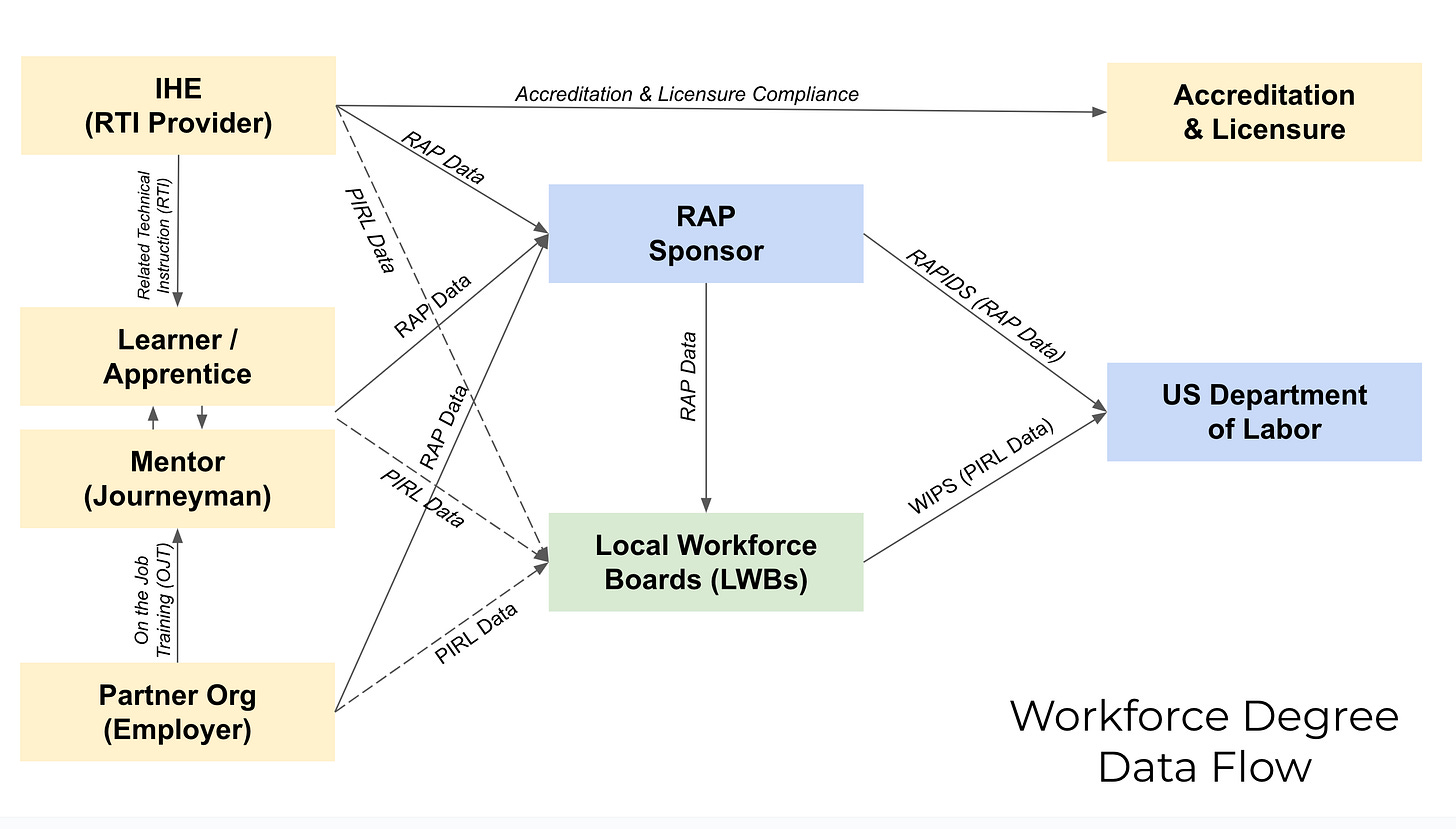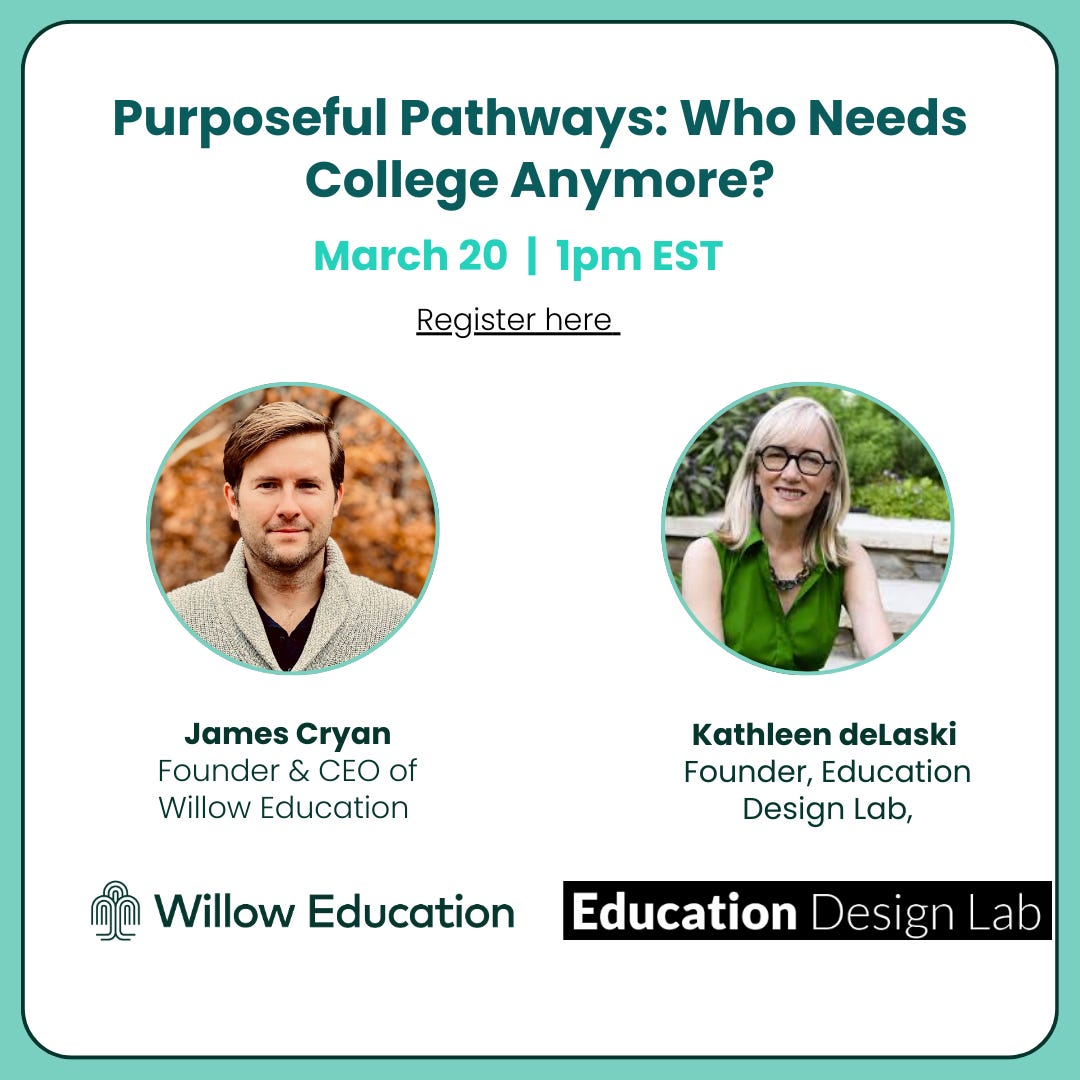What is an Apprenticeship Degree?
Reflections from my Purposeful Pathways conversation with Dr. Mallory Dwinal-Palisch
Last week, I hosted our latest Purposeful Pathways conversation with Dr. Mallory Dwinal-Palisch, who leads Craft Education at Western Governors University. Mallory is one of those rare leaders who can push the boundaries of big, disruptive ideas and do the (harder) real work of building institutions to bring those ideas to life.
It was a fun one! You can watch the whole conversation here. Here are some of my key takeaways:
Five Pillars of Apprenticeship Degrees
An apprenticeship degree is a degree you earn while working, where your coursework and work both contribute to and count for your learning and growth.
Efficient: 50% of credits coming from actual work experience.
Flexible: On the job. The best programs eliminate barriers around childcare, transportation, and work schedules.
Relevant: No disconnect between theory and practice. What students learn in class on Monday, is applied at work on Tuesday.
Affordable: $8,000 or less annually, with most students paying under $75/month.
Job-connected: There's a good job waiting for students in their community when they graduate. This isn't about credentials in search of opportunities - it's about matching actual openings with skilled local talent.
Remarkable Progress (And Still a Lot of Need)
The early growth in apprenticeship degrees has been remarkable. In 2020, a funder told Mallory, "There's no such thing as an apprenticeship degree." Today, 47 states have teaching apprenticeship programs, and over 5,000 learners have trained through Craft's system.
This progress is encouraging, but the scale of the challenge remains immense - across the country we still have 50,000 teacher vacancies and 300,000 under-credentialed positions across. As someone who has led schools, I've seen firsthand how challenging it can be to find great teachers.
Braiding Funding: Wonky, but Important
One of the most illuminating parts of our conversation centered on funding. The challenge isn't a lack of resources - it's that the resources exist in different "operating systems" that don't talk to each other:
Pell Grants live in higher education
WIOA funding lives in the workforce world
Using both together requires navigating 584 local workforce boards, each with its own processes
As Mallory showed us in Craft’s overview deck (below), this creates a spiderweb of over 500 variables that must be reported quarterly. No wonder many institutions say, "It's not worth the hassle."
Results for (L)earners
The early results are promising. At Reach University, where Mallory previously served as founder:
90% of participants came from historically excluded groups
Students graduate at higher rates than traditional students
Graduates stay in teaching positions longer and perform as well or better in the classroom
This resonates because we saw similar results at Rocky Mountain Prep. Real people finding economic mobility through good work is something worth celebrating.
A Spiky Point of View on Career Preparation
Mallory shared a perspective I think about a fair amount: We coddle students too much. Employers need to know that young people will:
Show up on time
Stay focused on work
Handle real responsibilities
Her suggestion? Let high school students experience real workplace consequences, including the possibility of being fired from work experiences. It's controversial, but there's wisdom here about preparing students for actual workplace expectations.
How Will AI Change Things?
Mallory shared the three key areas she’s watching:
Matching employer needs with training content in real-time
Actually validating skills (beyond self-attestation on LinkedIn)
Creating personalized learning pathways - or as Mallory put it, "making exact change" for each learner's needs
In my mind, the opportunity and need are clear: There are 8 million skilled labor vacancies and 50-60 million working adults seeking better opportunities. I am very bullish on Mallory’s work at Craft Education, a nonprofit division of Western Governor’s University
At Willow, we help young people discover their purpose, explore careers and postsecondary programs, make the most of high school, and find the next best step after graduation. From my perspective, considering apprenticeship degrees is a no-brainer.
We’ve got a new website!
Check it out and share any feedback, please!
Onward,
James
Purposeful Pathways is a newsletter and conversation series focused on transformative approaches to economic and social mobility through education. Join us in March for our next conversation with Kathleen deLaski, a mentor of mine, about her provocative and important new book.



